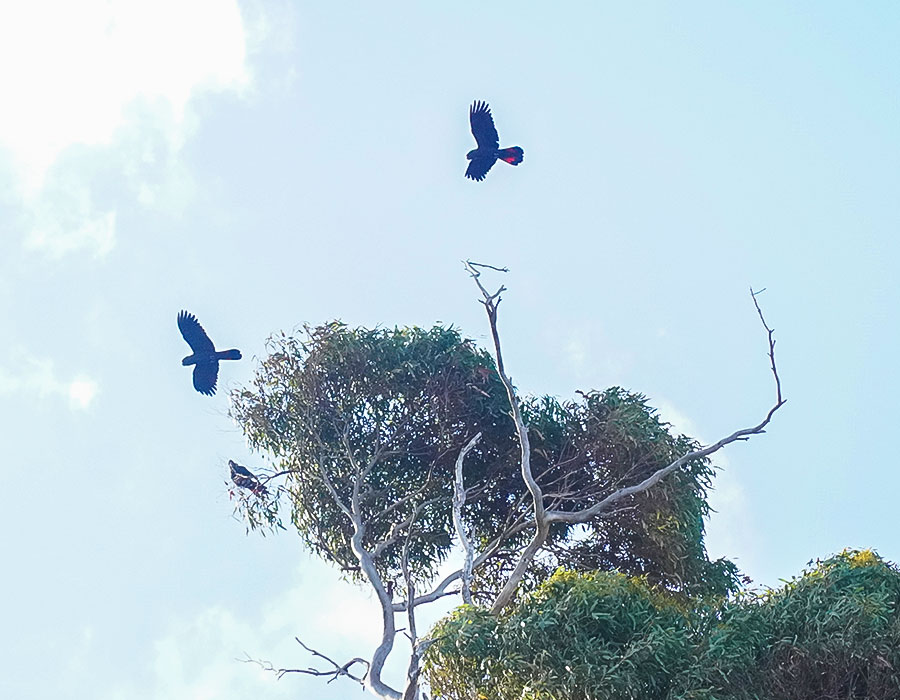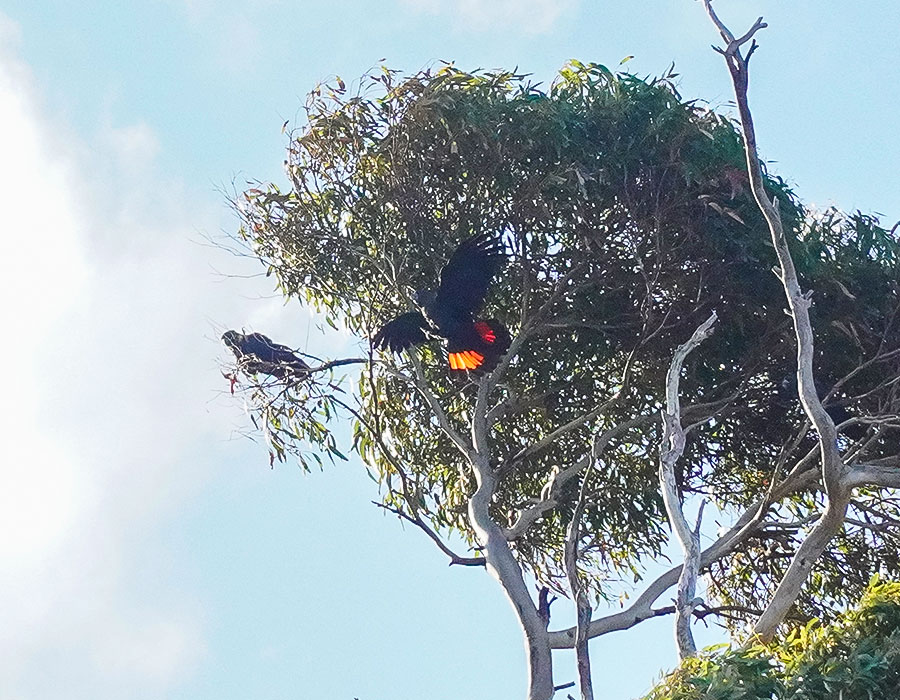The Glossy Black Cockatoo is a unique and captivating bird species that calls Kangaroo Island home. This beautiful black bird with its stunning red tail feathers has become a symbol of conservation efforts in the region. In this article, we will explore the various aspects of Glossy Black Cockatoos and their importance in the ecosystem, as well as the challenges they face and the steps being taken to protect them.

Glossy Black Cockatoos, American River

Glossy Black Cockatoos, American River
Conservation Efforts for the Glossy Black Cockatoo
Conservation organizations and local communities have come together to implement various measures to protect and preserve the Glossy Black Cockatoo population on Kangaroo Island. One of the key initiatives is the establishment of protected areas and sanctuaries that provide a safe haven for the birds and their habitat. These protected areas are carefully managed to ensure the long-term survival of the species.
Additionally, education and awareness programs have been implemented to educate both locals and visitors about the importance of protecting the Glossy Black Cockatoo. These programs aim to instill a sense of responsibility and promote sustainable practices that help conserve the unique ecosystem of Kangaroo Island.
Furthermore, research efforts are ongoing to better understand the behavior, breeding patterns, and habitat requirements of the Glossy Black Cockatoo. Scientists and conservationists are conducting field studies and monitoring programs to gather valuable data that can inform future conservation strategies. By studying the cockatoo’s movements and foraging habits, researchers can identify critical areas for protection and develop targeted conservation plans.
Another crucial aspect of conservation efforts is community engagement. Local residents, landowners, and indigenous groups play a vital role in protecting the Glossy Black Cockatoo’s habitat. Collaborative projects and partnerships are established to involve the community in conservation activities, fostering a sense of stewardship and ensuring long-term commitment to preserving the natural environment for future generations.
The Role of Glossy Black Cockatoos in the Ecosystem
In addition to their role in seed dispersal, Glossy Black Cockatoos also provide critical habitat for other wildlife. The large hollows they create in mature trees serve as nesting sites for other bird species and small mammals. Without the presence of Glossy Black Cockatoos, the ecosystem would suffer from a lack of biodiversity and the loss of important ecological interactions.
Furthermore, Glossy Black Cockatoos are known for their unique feeding habits, which involve extracting seeds from cones of various tree species. This specialized feeding behavior not only helps in seed dispersal but also plays a role in shaping the structure of the forest. By targeting specific tree species for feeding, Glossy Black Cockatoos influence the distribution and abundance of different plant communities, ultimately impacting the overall ecosystem dynamics.
Moreover, the distinctive vocalizations of Glossy Black Cockatoos serve as a form of communication within their social groups. These calls vary in pitch and intensity, conveying different messages such as warnings of danger, locations of food sources, and establishing territorial boundaries. The intricate social structure of Glossy Black Cockatoos adds another layer of complexity to the ecosystem, highlighting the interconnectedness of species within the natural environment.
In addition to the aforementioned threats, disease outbreaks represent another significant challenge for the Glossy Black Cockatoo population. Infectious diseases, such as Psittacine Beak and Feather Disease (PBFD), can spread rapidly among bird populations, leading to high mortality rates and reduced reproductive success. The transmission of diseases can be facilitated by factors like overcrowding at feeding sites or nesting areas, making the already vulnerable Glossy Black Cockatoos even more susceptible to health crises.Furthermore, human activities, such as illegal poaching and the illegal wildlife trade, present a direct threat to the Glossy Black Cockatoo population. These activities not only disrupt the natural balance of the ecosystem but also contribute to the decline of already endangered species. Conservation efforts must not only focus on addressing environmental challenges but also on combating illegal practices that directly harm wildlife populations.It is crucial for conservationists, policymakers, and local communities to work together to address these multifaceted threats facing the Glossy Black Cockatoo population. By implementing comprehensive conservation strategies that tackle habitat loss, predation, disease outbreaks, and human-induced threats, we can strive to ensure the long-term survival and well-being of these iconic birds on Kangaroo Island and beyond.
How to Spot a Glossy Black Cockatoo in the Wild
If you ever find yourself exploring Kangaroo Island, keep an eye out for the telltale signs of Glossy Black Cockatoos. Spotting these captivating birds requires a keen eye and patience, as they can be elusive and blend well with their surroundings.
Look for large, mature trees where Glossy Black Cockatoos tend to roost and nest. These trees, often found in woodland areas, provide the birds with essential resources. Keep an ear out for their distinctive calls, which can be helpful in locating them. The Glossy Black Cockatoo’s call is a unique mix of high-pitched whistles, squawks, and screeches that can be heard from a distance.
When observing Glossy Black Cockatoos, pay attention to their feeding habits. These birds primarily feed on the seeds of casuarina and sheoak trees, using their strong beaks to crack open the tough seed pods. Watching them feed can be a fascinating sight, as they skillfully extract the seeds with precision.
Another key behavior to look out for is their social interactions. Glossy Black Cockatoos are known for their strong pair bonds and tight-knit family groups. You may witness displays of affection between mates, such as mutual preening and gentle beak tapping. These interactions not only strengthen their bond but also play a crucial role in their social structure.
The Importance of Kangaroo Island for Glossy Black Cockatoo Conservation
Kangaroo Island is a critical stronghold for the Glossy Black Cockatoo population, hosting around 80% of the species’ total population. The island’s diverse vegetation, including the sheoak trees that the birds rely on for food and nesting, makes it an ideal habitat for these iconic birds.
Conserving the Glossy Black Cockatoo population on Kangaroo Island is not only crucial for the preservation of the species itself but also for maintaining the health and integrity of the island’s unique ecosystem. The continued efforts to protect the Glossy Black Cockatoo population contribute to the overall conservation goals and highlight the significance of Kangaroo Island as a biodiversity hotspot.
Moreover, Kangaroo Island’s geographical isolation has played a vital role in safeguarding the Glossy Black Cockatoo population from threats such as habitat destruction and invasive species. This isolation has allowed the birds to thrive in a relatively undisturbed environment, free from many of the pressures faced by their mainland counterparts.
The presence of the Glossy Black Cockatoo on Kangaroo Island also serves as a valuable indicator of the overall health of the island’s ecosystem. As a flagship species, the conservation of the cockatoo indirectly benefits numerous other plant and animal species that share its habitat, creating a ripple effect of biodiversity preservation across the island.
Exploring the Habitat of the Glossy Black Cockatoo
If you’re interested in experiencing the habitat of the Glossy Black Cockatoo firsthand, Kangaroo Island offers excellent opportunities for exploration. The island is home to several national parks and reserves where you can observe these magnificent birds in their natural environment.
Take a hike through the dense shrublands and woodland areas of Flinders Chase National Park, where you may spot Glossy Black Cockatoos feeding or flying overhead. The park’s diverse flora and fauna make it an enchanting place to immerse yourself in nature and appreciate the beauty of this unique ecosystem.
Remember to respect the birds and their habitat by observing from a safe distance and following any guidelines or restrictions in place to protect their wellbeing. By appreciating and understanding the importance of the Glossy Black Cockatoo’s habitat, we can all contribute to their conservation and help secure their future on Kangaroo Island.
Aside from Flinders Chase National Park, another notable area on Kangaroo Island to explore the habitat of the Glossy Black Cockatoo is the Kelly Hill Conservation Park. This park is known for its limestone caves, expansive woodlands, and diverse birdlife, providing a rich tapestry of habitats for various species, including the Glossy Black Cockatoo.
As you traverse the trails of Kelly Hill Conservation Park, keep an eye out for the distinctive calls of the Glossy Black Cockatoo echoing through the trees. These birds play a crucial role in the ecosystem by dispersing seeds and shaping the landscape through their foraging habits.
By venturing into these protected areas and witnessing the Glossy Black Cockatoo in its natural habitat, you not only gain a deeper appreciation for Australia’s wildlife but also become a steward of conservation, advocating for the preservation of these vital ecosystems for future generations to enjoy.
